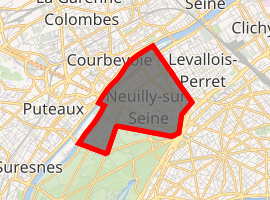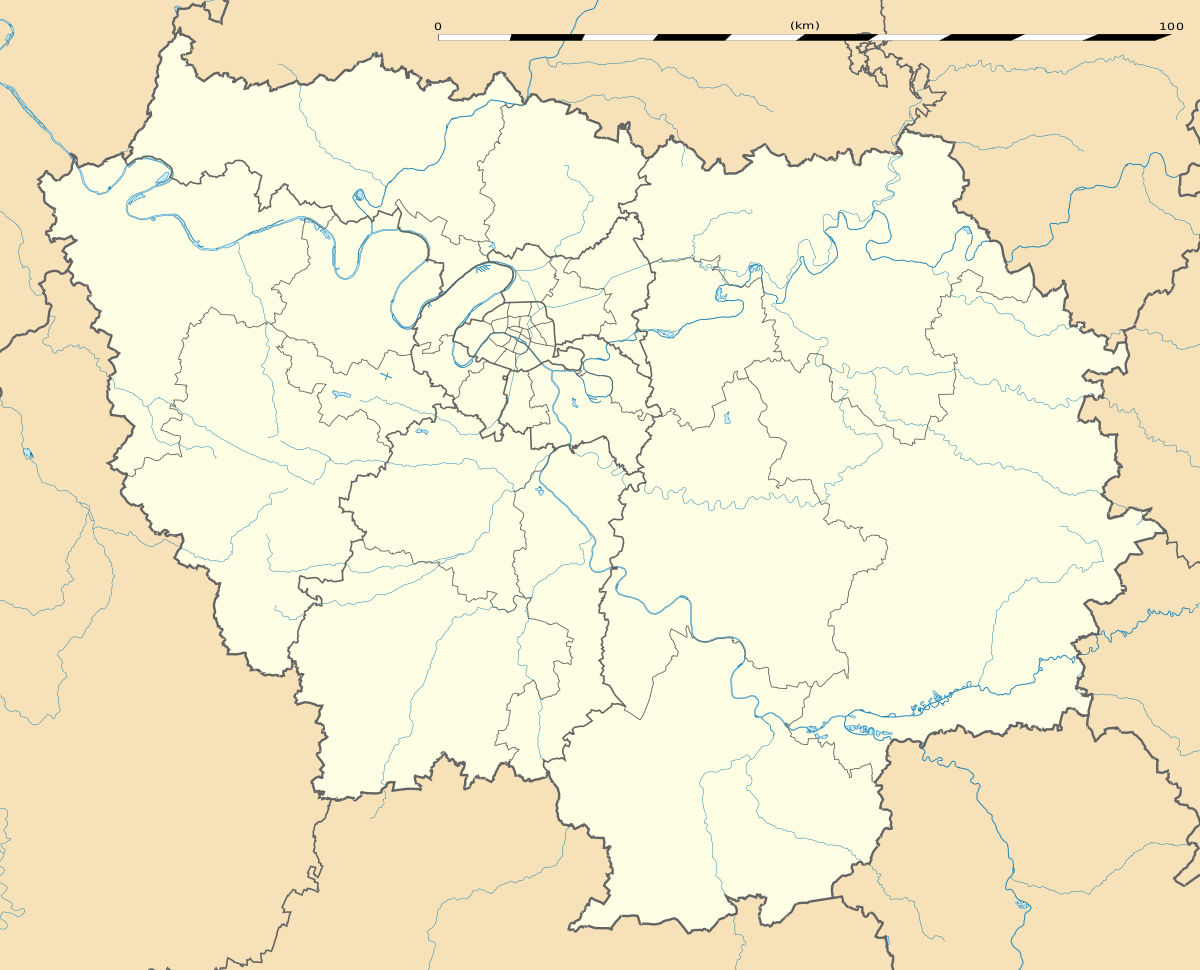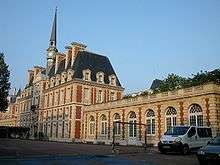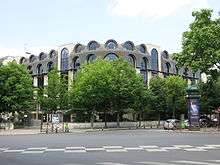Neuilly-sur-Seine
Neuilly-sur-Seine (French pronunciation: [nøji syʁ sɛn] (![]()
Neuilly-sur-Seine | |
|---|---|
Neuilly-sur-Seine Town Hall | |
.svg.png) Coat of arms | |
 Neuilly-sur-Seine within the Petite Couronne | |
Location of Neuilly-sur-Seine 
| |
 Neuilly-sur-Seine Neuilly-sur-Seine within the Petite Couronne  Neuilly-sur-Seine Neuilly-sur-Seine (Île-de-France (region)) | |
| Coordinates: 48°53′17″N 2°16′07″E | |
| Country | France |
| Region | Île-de-France |
| Department | Hauts-de-Seine |
| Arrondissement | Nanterre |
| Canton | Neuilly-sur-Seine |
| Intercommunality | Grand Paris |
| Government | |
| • Mayor (2020-2026) | Jean-Christophe Fromantin |
| Area 1 | 3.73 km2 (1.44 sq mi) |
| Population (2017-01-01)[1] | 60,361 |
| • Density | 16,000/km2 (42,000/sq mi) |
| Time zone | UTC+01:00 (CET) |
| • Summer (DST) | UTC+02:00 (CEST) |
| INSEE/Postal code | 92051 /92200 |
| Elevation | 27–39 m (89–128 ft) |
| 1 French Land Register data, which excludes lakes, ponds, glaciers > 1 km2 (0.386 sq mi or 247 acres) and river estuaries. | |
Together with the 16th and 7th arrondissement of Paris, the town of Neuilly-sur-Seine forms the most affluent and prestigious residential area in the whole of France.[4]
History
Originally Pont de Neuilly was a small hamlet under the jurisdiction of Villiers, a larger settlement mentioned in medieval sources as early as 832 and now absorbed by the commune of Levallois-Perret. It was not until 1222 that the little settlement of Neuilly, established on the banks of the Seine, was mentioned for the first time in a charter of the Abbey of Saint-Denis: the name was recorded in Medieval Latin as Portus de Lulliaco, meaning "Port of Lulliacum." In 1224 another charter of Saint-Denis recorded the name as Lugniacum. In a sales contract dated 1266, the name was also recorded as Luingni.
In 1316, however, in a ruling of the parlement of Paris, the name was recorded as Nully, a different name from those recorded before. In a document dated 1376 the name was again recorded as Nulliacum (the Medieval Latin version of Nully). Then in the following centuries the name recorded alternated between Luny and Nully, and it is only after 1648 that the name was definitely set as Nully. The name spelt Neuilly after the French Academy standard of pronunciation of the ill as a y (see IPA at the top).
Various explanations and etymologies have been proposed to explain these discrepancies in the names of Neuilly recorded over the centuries. The original name of Neuilly may have been Lulliacum or Lugniacum, and that it was only later corrupted into Nulliacum / Nully. Some interpret Lulliacum or Lugniacum as meaning "estate of Lullius (or Lunius)", probably a Gallo-Roman landowner. This interpretation is based on the many placenames of France made up of the names of Gallo-Roman landowners and suffixed with the traditional placename suffix "-acum." Other researchers, however, object that it is unlikely that Neuilly owes its name to a Gallo-Roman patronym, because during the Roman occupation of Gaul the area of Neuilly was inside the large Forest of Rouvray, of which the Bois de Boulogne is all that remains today, and was probably not a settlement.
These researchers contend that it is only after the fall of the Roman Empire and the Germanic invasions that the area of Neuilly was deforested and settled. Thus, they think that the name Lulliacum or Lugniacum comes from the ancient Germanic word lund meaning "forest", akin to Old Norse lundr meaning "grove", to which the placename suffix "-acum" was added. The Old Norse word lundr has indeed left many placenames across Europe, such as the city of Lund in Sweden, the Forest of the Londe in Normandy, or the many English placenames containing "lound", "lownde", or "lund" in their name, or ending in "-land." This interesting theory, however, fails to explain why the "d" of lund is missing in Lulliacum or Lugniacum.
Concerning the discrepancy in names over the centuries, the most probable explanation is that the original name Lulliacum or Lugniacum was later corrupted into Nulliacum / Nully by inversion of the consonants, perhaps under the influence of an old Celtic word meaning "swampy land, boggy land" (as was the land around Neuilly-sur-Seine in ancient times) which is found in the name of many French places anciently covered with water, such as Noue, Noë, Nouan, Nohant, etc. Or perhaps the consonants were simply inverted under the influence of the many settlements of France called Neuilly (a frequent place name whose etymology is completely different from the special case of Neuilly-sur-Seine).
Until the French Revolution, the settlement was often referred to as Port-Neuilly, but at the creation of French communes in 1790 the "Port" was dropped and the newly born commune was named simply Neuilly.
On 1 January 1860, the city of Paris was enlarged by annexing neighbouring communes. On that occasion, a part of the territory of Neuilly-sur-Seine was annexed by the city of Paris, and forms now the neighbourhood of Ternes, in the 17th arrondissement of Paris.
On 11 January 1867, part of the territory of Neuilly-sur-Seine was detached and merged with a part of the territory of Clichy to create the commune of Levallois-Perret.
On 4 June 1878, a Synagogue was founded on Rue Ancelle, which is the oldest synagogue of Paris' suburbs.
On 2 May 1897, the commune name officially became Neuilly-sur-Seine (meaning "Neuilly upon Seine"), in order to distinguish it from the many communes of France also called Neuilly. Most people, however, continue to refer to Neuilly-sur-Seine as simply "Neuilly." During the 1900 Summer Olympics, it hosted the basque pelota events.[5]
The American Hospital of Paris was founded in 1906.
In 1919, the Treaty of Neuilly was signed with Bulgaria in Neuilly-sur-Seine to conclude its role in World War I.
In 1929, the Bois de Boulogne, which was hitherto divided between the communes of Neuilly-sur-Seine and Boulogne-Billancourt, was annexed in its entirety by the city of Paris.
Population
| Year | Pop. | ±% |
|---|---|---|
| 1962 | 72,773 | — |
| 1968 | 70,995 | −2.4% |
| 1975 | 65,983 | −7.1% |
| 1982 | 64,170 | −2.7% |
| 1990 | 61,768 | −3.7% |
| 1999 | 59,848 | −3.1% |
| 2006 | 61,741 | +3.2% |
| 2017 | 60,361 | −2.2% |
Main sites
It was the site of the Château-de-Neuilly, an important royal residence during the July Monarchy.
Transport
Neuilly-sur-Seine is served by three stations on Paris Métro Line 1: Porte Maillot (with a direct access to RER line C), Les Sablons and Pont de Neuilly.
RATP Bus service includes the lines 43, 73, 82, 93, 157, 158, 163, 164, 174
Night Bus lines include N11 and N24.
Economy
Located near France's main business district La Défense, Neuilly-sur-Seine also hosts several corporate headquarters: Bureau Veritas, Chanel, Marathon Media, JCDecaux,[6] Thales Group,[7] M6 Group, Sephora, PricewaterhouseCoopers France, Parfums Christian Dior (in 2019), Orangina France, Grant Thornton International France.
Education
Public schools in Neuilly:[8]
- Eight écoles maternelles (preschools): Achille Peretti, Charcot, Dulud, Gorce-Franklin, Michelis, Poissoniers, Roule, Saussaye
- Ten elementary schools: Charcot A, Charcot B, Gorce-Franklin, Huissiers, Poissoniers, Peretti, Michelis A, Michelis B, Saussaye A, and Saussaye B
- Two lower secondary schools: Collège André Maurois and Collège Théophile Gautier.
- Collège et Lycée Pasteur
- Lycée Saint-James
- Lycée professionnel Vassily kandinsky
Domestic private schools:[9]
- École primaire Sainte-Croix
- École primaire Sainte-Marie
- École primaire Saint-Dominique
- École Saint-Pierre / Saint Jean
- Collège Saint-Pierre / Saint-Jean
- Collège et Lycée Sainte-Croix
- Collège et Lycée Sainte-Marie
- Collège et Lycée Saint-Dominique
- Lycée professionnel Georges Guérin
International private schools:[9]
- Liceo Español Luis Buñuel, Spanish international secondary and baccalaureate school
- Marymount School, Paris, a Catholic, co-educational, day school for 2-14 year olds
Post-secondary:
Notable residents
- King Nicholas I of Montenegro and his family
- Marie Angliviel de la Beaumelle, French glass maker and Italian countess
- Jean de La Fontaine, French poet and fabulist
- Natalie Barney, American heiress
- Ahmad Shah Qajar, the last king of Iran's Qajar dynasty
- André Beaufre, French general
- Jean-Paul Belmondo, French actor
- Liliane Bettencourt, L'Oréal heiress
- Françoise Bettencourt Meyers, Liliane Bettencourt's daughter
- Carole Bouquet, actress
- Jonathan Bru, footballer
- Bette Davis, non-resident, died at the American Hospital
- Marcel Duchamp, artist
- Jacqueline François (1922–2009), chanson singer
- France Gall, French singer
- Adrien Étienne Gaudez, French sculptor
- Paul Grimault, animator
- Screamin' Jay Hawkins, Shock rock musician
- Guy-Manuel de Homem-Christo, half of music duo Daft Punk
- Quincy Jones, musician, composer, producer
- Wassily Kandinsky, Russian Abstract-Expressionist artist
- Karl Lagerfeld, German fashion designer
- Sophie Marceau, French actress
- Roger Martin du Gard, winner of 1937 Nobel Prize for Literature
- Mireille Mathieu, chanson singer, has been a resident since 1965
- Olivier Missoup, rugby player
- Ilona Mitrecey, Eurodance artist
- Corentin Moutet, tennis player
- Christoph H. Müller musician, composer, co-founder of Neotango band Gotan Project
- Joachim Murat, Prince of Pontecorvo, aristocrat
- Anaïs Nin, author and diarist, born in Neuilly-sur-Seine
- Allan Nyom, footballer
- Michel Berger, singer and songwriter.
- Aristotle Onassis died on 15 March 1975 at the American Hospital
- Jean d'Ormesson, French novelist member of the Académie française
- Marine Le Pen, French politician : president of the Front National
- Édith Piaf, French singer
- Jacques Prévert, poet and screenwriter
- Jean Raspail, French writer
- Pierre Ramond, string theorist
- Jean Riboud (1919–1985) French corporate executive and former chairman of Schlumberger
- Nicolas Sarkozy, former President of France; mayor of Neuilly-sur-Seine from 1983 to 2002
- David Servan-Schreiber (1961–2011)
- René Semelaigne (1855–1934), biographer
- Vittorio De Sica, Italian actor and film director
- Martin Solveig, French electro-house DJ.
- Dominique Strauss-Kahn (born 25 April 1949)
- François Truffaut, French film director, actor
- Albert Uderzo, writer and illustrator (1927–2020)
- Ludovic Valbon, rugby player
- The Duke and Duchess of Windsor
- Mary Wollstonecraft, English writer
- Arthur Zagre, footballer
- Jacques Zwobada, French sculptor
- María Félix, Mexican actress
- Prince Umberto of Savoy-Aosta, eldest son of the Duke of Apulia and Princess Olga of Greece
- Prince Michel of Bourbon-Parma, died here[10]
- Joseph Haim Sitruk (1944-2016), former Chief Rabbi of France.
- Annie Fargé, actress, theatrical producer and manager. Died here.
Twin towns – sister cities
Neuilly-sur-Seine is twinned with:[11]
See also
- Communes of the Hauts-de-Seine department
- Neuilly-Auteuil-Passy
- Neuilly sa mère!, 2009 film set in Neuilly-sur-Seine
References
- "Populations légales 2017". INSEE. Retrieved 6 January 2020.
- "Dans quelles communes paie-t-on le plus l'ISF?". Lefigaro.fr. 7 November 2017. Retrieved 25 March 2019.
- "How Brexit has made a Paris suburb the most expensive place to buy property in France". Thelocal.fr. 29 October 2018. Retrieved 25 March 2019.
- https://www.capital.fr/votre-argent/les-80-communes-ou-se-concentrent-les-plus-hauts-revenus-866459
- Sports-reference.com Summer Olympics Paris 14 June 1900 men's basque pelota two-teams results., Sports-reference.com, Accessed 14 November 2010.
- "Legal disclaimer Archived 2014-03-16 at the Wayback Machine." [sic] JCDecaux. Retrieved on 28 September 2011. "[...]whose registered office is located at 17 rue Soyer, 92523 Neuilly-sur-Seine, Paris, France."
- "Contact Us Archived 2009-08-23 at the Wayback Machine." Thales Group, Retrieved on 28 August 2009.
- "Etablissements scolaires publics." Neuilly-sur-Seine. Retrieved on May 2, 2015.
- "Etablissements scolaires privés." Neuilly-sur-Seine. Retrieved on May 2, 2015.
- "Prince Michel of Bourbon-Parma, European royal and Allied paratrooper, dies at 92". The Washington Post.
- "Les vitrines des archives". neuillysurseine.fr (in French). Neuilly-sur-Seine. Retrieved 2019-11-16.
External links
| Wikimedia Commons has media related to Neuilly-sur-Seine. |
- . Encyclopædia Britannica. 19 (11th ed.). 1911. pp. 425–426.
- (in French) Neuilly-sur-Seine city council website

